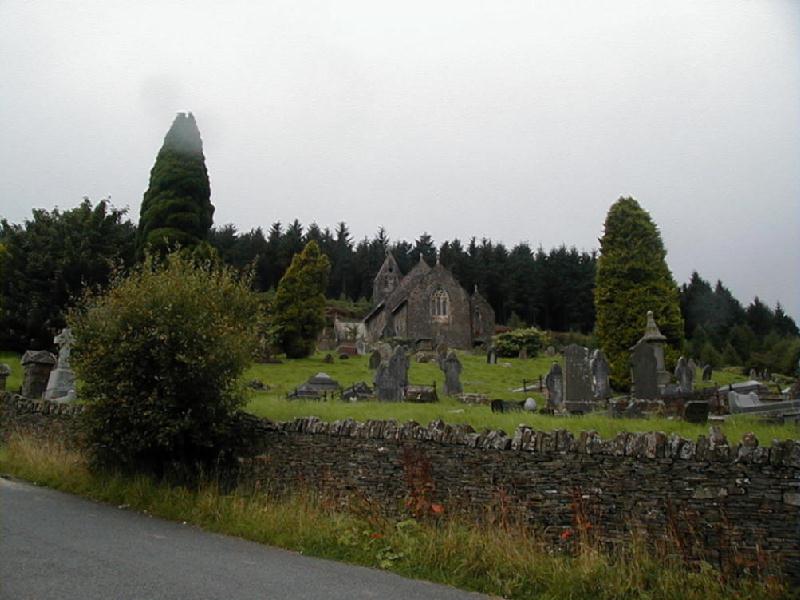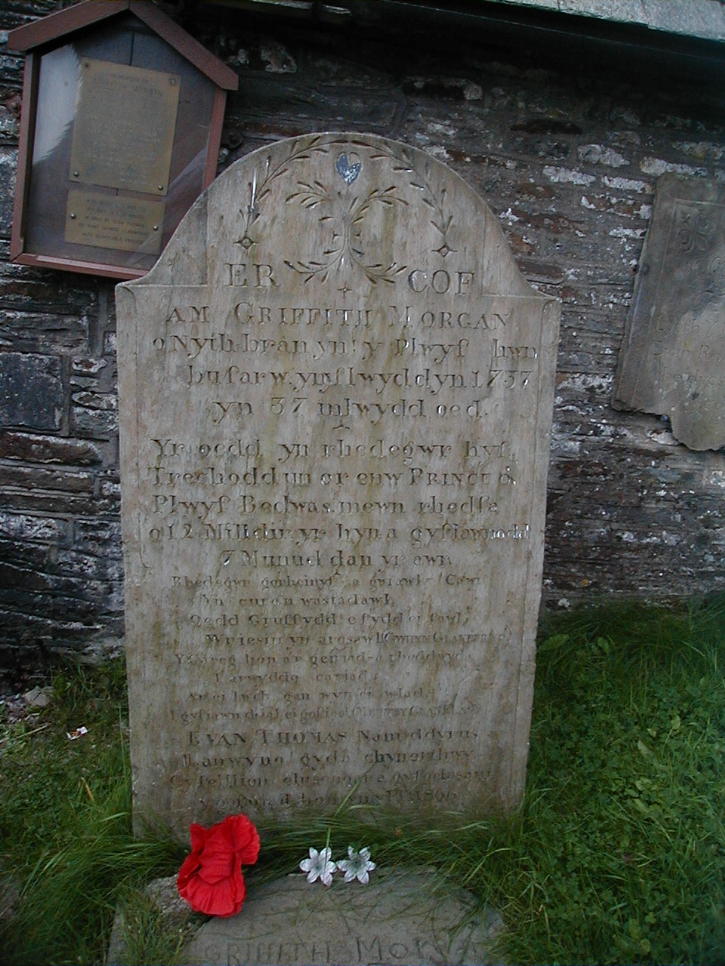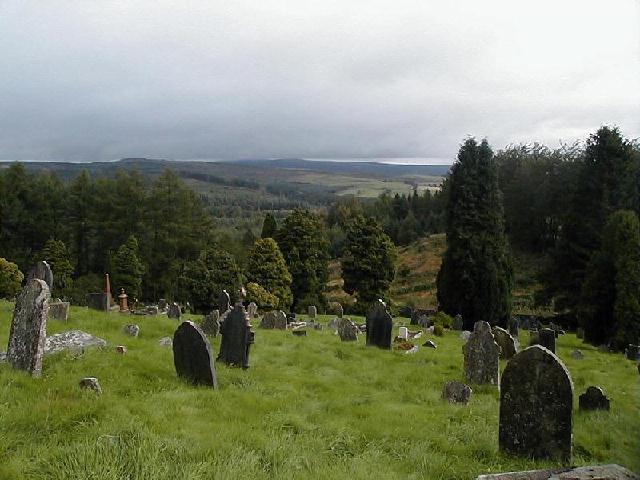Visitors Welcome

Visitors Welcome

The Church of St Gwynno, Llanwynno, Mid Glamorgan
J.GWYN DAVIES, B.A.
Nestling in the lea of bleak, wind-swept Cefn Gwyngul between the Rhondda
Fach and the Cynon Valley, the parish church of Llanwynno looks out upon
the surrounding hills as if it were the apparent last outpost of civilisation,
though the public house which stands no more than a score of yards away
might claim this distinction for itself with equal vigour and possibly
with more support. Yet, despite its isolated situation, Eglwyswynno possesses
an interesting past, for the church was at one time the centre of one of
the most important parishes in Glamorgan.
Eglwyswynno bears the name of Gwynno on two accounts: the church was
both founded by him and dedicated in his name. There is considerable disagreement
over the spelling of Gwynno's name. Some people prefer to spell it "Gwonno",
others "Gwynno" and yet others "Gwono". "Gwynno is the name recorded on
the oldest map of the parish, but the form "Gwonno" is fairly common.
Who was Gwynno? He remains a very obscure character indeed. It has
been suggested that he entered Britain during the Roman occupation, but
this is highly unlikely. Gwynno appears to have been the son of Cau, called
Euryn y Coed aur. E.G.Bowen in the Settlements of the Celtic Saints in
Wales tells how Gwyno came to found the church, which bears his name.
During the Yellow Plague of 547, the monks of the dead Illtud went
for safety from West Wales to Brittany. Instead of returning to Pembrokeshire,
they travelled east to Glamorgan to settle at Llantwit Major (Llanilltud
Fawr in Welsh). It appears that Saint Illtud's monks were accompanied to
Glamorgan by several of his disciples and associates, some of whom were
Bretons, represented by St Canna at Llangan, St Crallo at Coychurch, St
Isan at Llanishen, St Tyfodwg at Llandyfolwg, Ystradfodwg and Llantrisant,
St Curig at Porthkerry, and St Gwynno at Llanwynno and Llantrisant. Gwynno,
though not as famous as the other saints, nevertheless has a place among
the great company of Saints who helped to bring Christianity to Wales.
The farmhouse at Daearwynno was not far from the church; indeed Gwynno
may have lived there, and may have owned the land around it. It is significant
that the nearest farmhouse to the church was always known as Daearwynno
- Gwynno's land, But it is not clear whhether the land belonged to Gwynno
the Saint, or whether it was a later acquisition of the church. There is
no mention of Gwynno ever having performed miracles; no one knows of his
work, or of the whereabouts of his grave, and not one of his writings has
been preserved. Only Gwynno's name and Gwynno's church remain as a definite
indication that he really did exist and as a monument to his work.
The following is an extract ( translated from the Latin) from the Bibliotheca
Sanctorum V11 in the Vatican Library:
GWYNO, confessor, saint. The patron of Llanwonno, in Glamorganshire,
Church attached to Llantrisant. There is said to be a sacred well Ffynnon
Wyno. His feast day is celebrated on 26th October.
At the outset, the church was probably constructed either of timber
or of daub and wattle, and it was not until comparatively modern times
that the building took on the mantle of stone. Until 1894, the church resembled
a barn from the outside, with an appendage containing the chancel, and
a porch leading from the south wall (the last two features being incorporated
in the present building). Inside, the pulpit was a three-decker and was
situated on the north wall; the pews were interlocked and ran from east
to west. In 1894 the church was "restored" in the Gothic style by Miss
Olive Talbot of Margam. A belfry and a small porch on the west wall were
added. George E.Halliday was the architect for this work, and the cost
of the work was met from Miss Talbot's own purse. As a result of this work,
much of the historical interest of the building has been destroyed, though
the church now has a much more imposing appearance.
Inside the present building, however, there remain several features
of historical interest. Affixed to the south wall of the nave near the
south door, there is the upper portion of a rough pillar stone. It is 13
1/2 inches high, 8 1/2 inches wide and 3 1/2 inches thick. On it there
is a crudely incised ring-cross with four incised dots in the interspaces
and four smaller dots (one of which is fractured away) in the upper and
lower spandrels. It dates from the period between the seventh and ninth
centuries and is ranked among the early Christian monuments of Wales. There
is an ancient looking font, but here authenticity is doubtful.
Inside the vestry there is aboard on which is written:
BENEFACTIONS TO THE POOR OF THE PARISH OF LLANWONNO IN THE COUNTY OF
GLAMORGAN Edward Thomas of the Parish of Llanmihangel Llantarnam in the
County of Monmouth, Gent, Left by Will dated Febry 20th, 1678, Five Pounds
to be distributed the 21st day of Decer Yearly and for Ever by the Churchwardens
and Overseers of Llanwonno and their Successors to ten poor persons from
the Parish. Payable from Tir y Dduallt in the said Parish
This is a very interesting feature of the life of the parish and is
now administered by the Vicar, Churchwardens and the former Cynon Valley
Borough Council. "I remember," says Glanffrwd in his Hanes Plwyf Llanwynno,
when there were not enough poor to take the money and it was necessary
for the distributors to search the parish for people who would be kind
enough to take the gift of ten shillings." This custom had close links
with Eglwyswynno - the money was paid by the officers of the church, and
the actual payments were made in the south porch of the church.
The church contains quite a number of tombs, most of which date from
the eighteenth century. The timeworn gravestones provide a contrast with
the more modern brass commemorative plaques to be found on the walls. Outside
the church there is an extensive graveyard; the oldest gravestone is that
of Christina, wife of James Pitt, who died in 1667, aged 42 years. Many
of the gravestones remain remarkably legible, despite the considerable
battering which they have received from the elements. Inscriptions on the
gravestones are both English and Welsh, though in the graveyard itself
Welsh predominates, whereas inside the church most of the gravestones bear
English inscriptions. This is an interesting feature, which reflects the
increasing Anglicisation of the "upper-class" of the parish, who would
be buried inside the church. The graveyard of Llanwonno has inspired local
poets of days gone by (excerpts from their poems to the graveyard may be
found, for example, in Glanffrwd's work). The spirit of poetry certainly
seems to steal around the cemetery, singing on the myriad graves. The sight
of the graves, some upright, others leaning; yet others horizontal, marking
the spot where the inhabitants of the parish have been buried for centuries,
would inspire almost anyone. The graves provide almost as great a link
with the past as does Eglwyswynno itself, with all its associations with
the early Christian era in Wales.
In pre-Norman Wales there was no such thing as a parochial system.
After the Norman Conquest, however, internal developments within the Welsh
Church supported by influences from England and abroad led to the grouping
of churches into parish churches and chapelries, and the parochial system
as we know it began to emerge in Wales. In the Diocese of Llandaff there
were Mother Churches, and these had out-stations, which were served by
chaplains. Thus Llanwynno was the chapelry of the Church of Llantrisant,
which in its turn was in all probability an out-station of the Mother Church
at Llantwit Major.
The Commission of 1533 (Valor Ecclesiasticus) reveals that at that
time the revenue of Llanwynno was £5. From the Tudor Period onwards,
Llanwonno was a curacy under the Vicar of Llantrisant, who was the incumbent
of the Parish. The major tithes went to Gloucester cathedral (the Dean
and Chapter of which appointed the vicar of Llantrisant after the dissolution
of the monasteries, which control previously being vested in Tewkesbury
Abbey), whereas the minor tithes went to Llantrisant. Llanwynno possessed
two tithe-barns, one in Old Ynysybwl (now taken down), and another at Abercyon.
In the eighteenth century Llanwynno became independent of Llantrisant and
became a parish in its own right, the incumbent being known as the "perpetual
curate" or "vicar".
As is to be expected, many legends have grown up around the parish
church. It has been claimed that Eglwyswynno was erected on a Roman catacomb
containing not only the sacred remains of St Gwynno and his associates,
but being also the last resting-place of "large numbers of the extensive
Roman colony, which existed in the neighbourhood". To substantiate this,
it is indeed fairly certain that the Romans did penetrate the Clydach Valley.
Yet such a claim must be treated with caution, for very little evidence
is available relating to this period, and so any proposals put forward
must be of a very speculative nature.
There are two stories concerning the bell of the church; both seem
to be based on the same happening, though their treatment of the event
differs. One story relates how the people orf Llanfabon took a liking to
Llanwynno's silver bell and one night a band of them stole it. The other
story tells how the church bell, the communion plate, the linen altar cloth
and the pulpit cushion were once stolen. In the first story the bell was
dropped in the river Taff and never seen again, whereas in the second story
the thieves were captured and the bell retrieved.
Various place names in the parish are connected with the second story;
Ffos-y-gloch The ditch of the bell Rhyd-y-gloch The ford of the bell
Rhyd-y-car The ford of the sledge(on which the bell was carried and where
the thieves were captured).
It is quite likely, however, that the story was invented to explain
these place-names. Much doubt must be cast on the authenticity of these
stories, interesting as they may be.
Many famous people have lived in the parish since Eglwyswynno was first
erected. Unfortunately, however, their fame lasted only a short while after
their deaths. In Llanwynno lived one of the fastest runners ever known
(if legend be allowed to count for anything), Gruffydd Morgan (Guto Nyth
Bran) who once out-ran and caught a hare, who could keep up with the hounds,
and who won races against horses. His tragic death in 1737, as a result
of being slapped on the back after winning a race, caused great grief in
the parish, so much so that in 1866 a large tombstone was erected by public
subscription as a new memorial on Guto's grave, and it can be seen just
behind the wall of the south porch.

View from Llanwynno Church.
